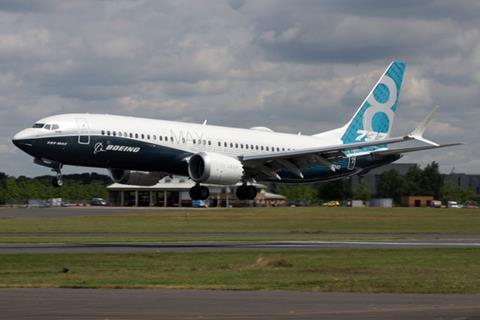A US congressional committee investigating the Boeing 737 Max has issued a preliminary report highlighting alleged failures by Boeing and the Federal Aviation Administration.
The report from the House Committee on Transportation and Infrastructure comes nearly one year after the deadly crash of Ethiopian Airlines flight 302, which prompted the global grounding.
The committee says its investigation remains ongoing and that it will introduce legislation in the coming weeks to “address failures in the certification process”.
“Developing a transport category commercial aircraft that is compliant with FAA regulations, but fundamentally flawed and unsafe highlights an aviation oversight system in desperate need of repair,” say the preliminary findings.
In a statement, Boeing says, “We have cooperated extensively for the past year with the committee’s investigation. We will review this preliminary report”.
The FAA says it “welcomes the observations” of the committee. “While the FAA’s certification processes are well-established and have consistently produced safe aircraft designs, we are a learning agency and welcome the scrutiny. We are confident that our openness to observations and recommendations will further bolster aviation safety worldwide.”
The committee’s report says Boeing placed undue “pressures” on the 737 Max programme and relied on “faulty assumptions” in developing the Max’s systems.
“There was tremendous financial pressure on Boeing and subsequently the 737 Max programme to compete with Airbus’ A320neo aircraft,” says the report.

The pressure resulted in cost cutting and intense efforts to meet schedule. “The committee’s investigation has identified several instances where the desire to meet these goals and expectations jeopardised the safety of the flying public,” it says.
The report notes that in 2012, to cut costs, Boeing reduced the Max’s avionics regression testing by 2,000 work-hours, cut flight-test support by 3,000h and slashed 8,000h of engineering flight deck simulator work.
The report faults Boeing for “concealment of crucial information” and cites “conflicts of interest” among Boeing staffers tasked with performing certification work.
“Our committee’s investigation will continue for the foreseeable future, as there are a number of leads we continue to chase down,” says committee chair Peter DeFazio in a statement.
The report says Boeing made faulty assumptions about pilot responses to activation of the Max’s Maneuvering Characteristics Augmentation System (MCAS). As a result, Boeing designed that system, which pushes the aircraft’s nose down, to rely on only a single angle-of-attack (AOA) indicator.
Investigators have said a faulty AOA sensor precipitated the October 2018 crash of a Lion Air 737 Max 8. The Ethiopian crash report remains outstanding. Those crashes killed 346 people.
The Lion Air accident report also cited notable problems with pilot performance and Lion’s maintenance and operations.
The committee’s report says Boeing “withheld crucial information from the FAA, its customers and 737 Max pilots” by failing to initially disclose the existence of MCAS. Boeing also did not initially inform airlines that an AOA disagree alert was inoperative.
At one point, an estimated 80% of 737 Max had inoperative AOA alerts, according to the report.
The report says “multiple career FAA officials documented” cases in which FAA managers, “at the behest of Boeing”, overruled FAA technical experts who had raised concern about the safety of Boeing’s design approaches.
Those cases involved the 737 Max and a lightning protection feature on the 787, it says.
The FAA’s “poor, disjointed” communications kept FAA employees from making “informed decisions”, the report adds.


























